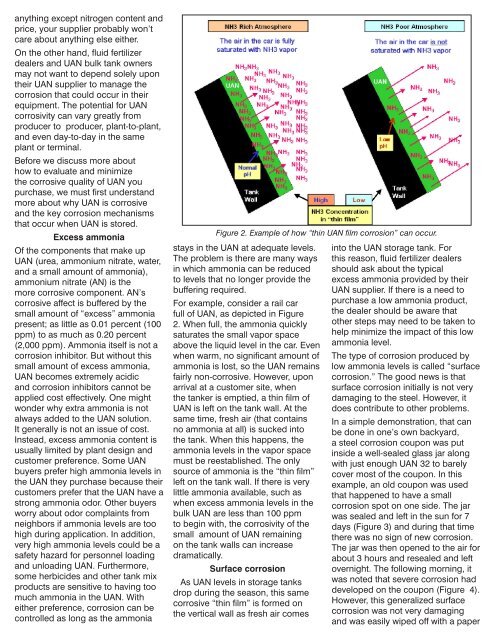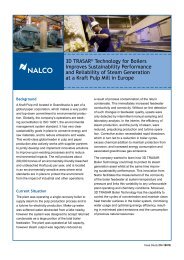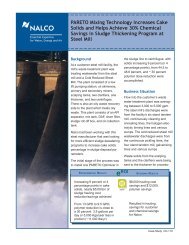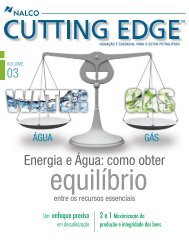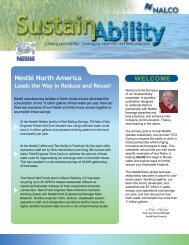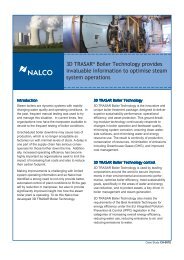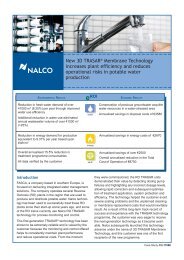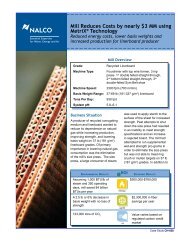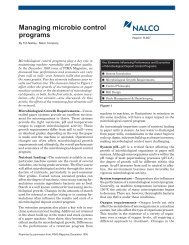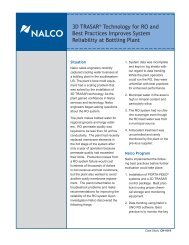Take UAN Corrosion Seriously - Nalco
Take UAN Corrosion Seriously - Nalco
Take UAN Corrosion Seriously - Nalco
You also want an ePaper? Increase the reach of your titles
YUMPU automatically turns print PDFs into web optimized ePapers that Google loves.
anything except nitrogen content and<br />
price, your supplier probably won’t<br />
care about anything else either.<br />
On the other hand, fluid fertilizer<br />
dealers and <strong>UAN</strong> bulk tank owners<br />
may not want to depend solely upon<br />
their <strong>UAN</strong> supplier to manage the<br />
corrosion that could occur in their<br />
equipment. The potential for <strong>UAN</strong><br />
corrosivity can vary greatly from<br />
producer to producer, plant-to-plant,<br />
and even day-to-day in the same<br />
plant or terminal.<br />
Before we discuss more about<br />
how to evaluate and minimize<br />
the corrosive quality of <strong>UAN</strong> you<br />
purchase, we must first understand<br />
more about why <strong>UAN</strong> is corrosive<br />
and the key corrosion mechanisms<br />
that occur when <strong>UAN</strong> is stored.<br />
Excess ammonia<br />
Of the components that make up<br />
<strong>UAN</strong> (urea, ammonium nitrate, water,<br />
and a small amount of ammonia),<br />
ammonium nitrate (AN) is the<br />
more corrosive component. AN’s<br />
corrosive affect is buffered by the<br />
small amount of “excess” ammonia<br />
present; as little as 0.01 percent (100<br />
ppm) to as much as 0.20 percent<br />
(2,000 ppm). Ammonia itself is not a<br />
corrosion inhibitor. But without this<br />
small amount of excess ammonia,<br />
<strong>UAN</strong> becomes extremely acidic<br />
and corrosion inhibitors cannot be<br />
applied cost effectively. One might<br />
wonder why extra ammonia is not<br />
always added to the <strong>UAN</strong> solution.<br />
It generally is not an issue of cost.<br />
Instead, excess ammonia content is<br />
usually limited by plant design and<br />
customer preference. Some <strong>UAN</strong><br />
buyers prefer high ammonia levels in<br />
the <strong>UAN</strong> they purchase because their<br />
customers prefer that the <strong>UAN</strong> have a<br />
strong ammonia odor. Other buyers<br />
worry about odor complaints from<br />
neighbors if ammonia levels are too<br />
high during application. In addition,<br />
very high ammonia levels could be a<br />
safety hazard for personnel loading<br />
and unloading <strong>UAN</strong>. Furthermore,<br />
some herbicides and other tank mix<br />
products are sensitive to having too<br />
much ammonia in the <strong>UAN</strong>. With<br />
either preference, corrosion can be<br />
controlled as long as the ammonia<br />
Figure 2. Example of how “thin <strong>UAN</strong> film corrosion” can occur.<br />
stays in the <strong>UAN</strong> at adequate levels.<br />
The problem is there are many ways<br />
in which ammonia can be reduced<br />
to levels that no longer provide the<br />
buffering required.<br />
For example, consider a rail car<br />
full of <strong>UAN</strong>, as depicted in Figure<br />
2. When full, the ammonia quickly<br />
saturates the small vapor space<br />
above the liquid level in the car. Even<br />
when warm, no significant amount of<br />
ammonia is lost, so the <strong>UAN</strong> remains<br />
fairly non-corrosive. However, upon<br />
arrival at a customer site, when<br />
the tanker is emptied, a thin film of<br />
<strong>UAN</strong> is left on the tank wall. At the<br />
same time, fresh air (that contains<br />
no ammonia at all) is sucked into<br />
the tank. When this happens, the<br />
ammonia levels in the vapor space<br />
must be reestablished. The only<br />
source of ammonia is the “thin film”<br />
left on the tank wall. If there is very<br />
little ammonia available, such as<br />
when excess ammonia levels in the<br />
bulk <strong>UAN</strong> are less than 100 ppm<br />
to begin with, the corrosivity of the<br />
small amount of <strong>UAN</strong> remaining<br />
on the tank walls can increase<br />
dramatically.<br />
Surface corrosion<br />
As <strong>UAN</strong> levels in storage tanks<br />
drop during the season, this same<br />
corrosive “thin film” is formed on<br />
the vertical wall as fresh air comes<br />
into the <strong>UAN</strong> storage tank. For<br />
this reason, fluid fertilizer dealers<br />
should ask about the typical<br />
excess ammonia provided by their<br />
<strong>UAN</strong> supplier. If there is a need to<br />
purchase a low ammonia product,<br />
the dealer should be aware that<br />
other steps may need to be taken to<br />
help minimize the impact of this low<br />
ammonia level.<br />
The type of corrosion produced by<br />
low ammonia levels is called “surface<br />
corrosion.” The good news is that<br />
surface corrosion initially is not very<br />
damaging to the steel. However, it<br />
does contribute to other problems.<br />
In a simple demonstration, that can<br />
be done in one’s own backyard,<br />
a steel corrosion coupon was put<br />
inside a well-sealed glass jar along<br />
with just enough <strong>UAN</strong> 32 to barely<br />
cover most of the coupon. In this<br />
example, an old coupon was used<br />
that happened to have a small<br />
corrosion spot on one side. The jar<br />
was sealed and left in the sun for 7<br />
days (Figure 3) and during that time<br />
there was no sign of new corrosion.<br />
The jar was then opened to the air for<br />
about 3 hours and resealed and left<br />
overnight. The following morning, it<br />
was noted that severe corrosion had<br />
developed on the coupon (Figure 4).<br />
However, this generalized surface<br />
corrosion was not very damaging<br />
and was easily wiped off with a paper


